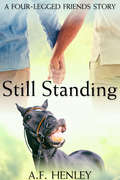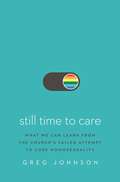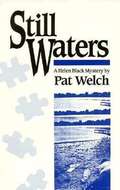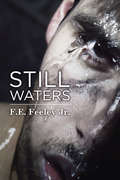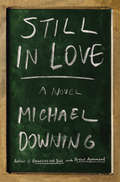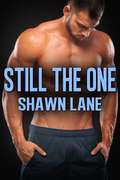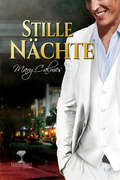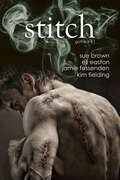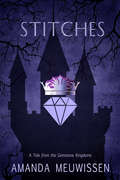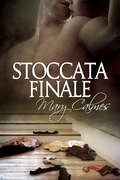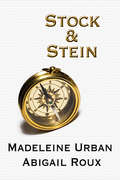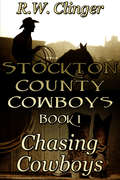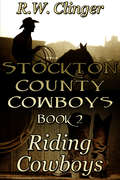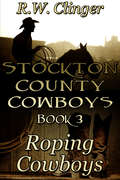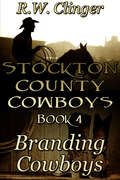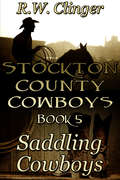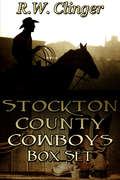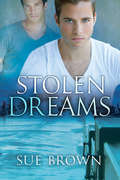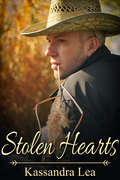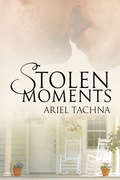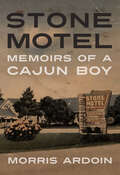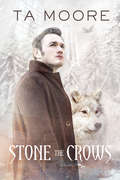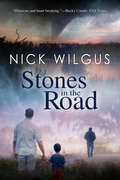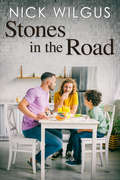- Table View
- List View
Still Standing
by A. F. HenleyBryson Merritt may have started life as a broken baby in a basket, but he got lucky with an extraordinary set of circumstances that brought him his adoptive parents. Rich, supportive, and kind, they've given Bryson everything he's ever needed in order to deal with his ongoing recovery issues. If only they could give him some luck when it comes to picking out the right kind of guy.When Bryson meets Duke at a horse auction, all he can think about is getting Duke's sweaty hands all over his body. Until he meets Beau -- the beautiful dark horse in Duke's care, who shares Bryson's mobility and pain issues -- and realises exactly where Beau's final destination is. Enraged by what he sees as an unfair, undeserving, and cruel punishment, Bryson decides to buy Beau, problems or not, experience or no, and walks away without looking back.However, once again forces have gathered to help Bryson out, and Bryson finds himself working alongside Duke for the sake of Beau. Bryson's attraction is rekindled, but now Duke isn't interested at all. Worse still, it looks like a possible relationship with Duke isn't the only thing that is going to end in tragedy.
Still Time to Care: What We Can Learn from the Church’s Failed Attempt to Cure Homosexuality
by Greg JohnsonCharting the path forward for our churches and ministries in providing care—not a cure— for our non-straight sisters and brothers who are living lives of costly obedience to Jesus.At the start of the gay rights movement in 1969, evangelicalism's leading voices cast a vision for gay people who turn to Jesus. It was C.S. Lewis, Billy Graham, Francis Schaeffer and John Stott who were among the most respected leaders within theologically orthodox Protestantism. We see with them a positive pastoral approach toward gay people, an approach that viewed homosexuality as a fallen condition experienced by some Christians who needed care more than cure.With the birth and rise of the ex-gay movement, the focus shifted from care to cure. As a result, there are an estimated 700,000 people alive today who underwent conversion therapy in the United States alone. Many of these patients were treated by faith-based, testimony-driven parachurch ministries centered on the ex-gay script. Despite the best of intentions, the movement ended with very troubling results. Yet the ex-gay movement died not because it had the wrong sex ethic. It died because it was founded on a practice that diminished the beauty of the gospel.Yet even after the closure of the ex-gay umbrella organization Exodus International in 2013, the ex-gay script continues to walk about as the undead among us, pressuring people like me to say, "I used to be gay, but I'm not gay anymore. Now I'm just same-sex attracted."For orthodox Christians, the way forward is to take a close look at our history. It is time again to focus with our Neo-Evangelical fathers on caring over attempting to cure.With warmth and humor, as well as original research, Still Time to Care provides:Guidance for the gay person who hears the gospel and finds themselves smitten by the life-giving call of Jesus.Guidance for the church to repent of its homophobia and instead offer gospel-motivated love and compassion.
Still Waters (Helen Black Mysteries #2)
by Pat WelchAn unsettling new case for Helen Black. Helen and Frieda are at a luxury lakeside resort for a weekend that will, hopefully, mark a new beginning. A weekend to heal the growing rift between them. The discovery of the battered body of a news reporter on the sandy beach changes everything. Because the victim is an old friend of Helen's, the weekend suddenly turns into a murder investigation and a new case for Private Investigator Helen Black. Does the story the reporter was working on hold the key? Or is her death an ex-lover's revenge? And what of the attractive, frightened Maria and her link with the enigmatic priest, Father John? Seemingly everyone has secrets. The apparently successful resort is in financial trouble. The hotel guests have their own frictions and deceptions. The angelic beauty of the owner's daughter masks dark needs...and is a new element to threaten the fragile relationship between Helen and Frieda.
Still Waters by F.E. Feeley Jr.
by F. E. Feeley JrMemoirs of the Human WraithsPromise, Michigan is very much like every other small town across the state. Built on the edge of a lake, the homes sit in neat little rows in cute little neighborhoods. During the summer Promise bustles with tourists who come to spend their vacation dollars and enjoy the lake's refreshingly cold water. But Promise holds a terrible secret. In the center of the lake is an abandoned island where a curse is rumored to wait for victims, unabated and deadly. Most think it's just a story, something used to keep kids out of trouble. Still, everyone gives it a wide berth. Everyone except Bret and Adam. They dare to venture out the night of Bret's birthday. When they declared their love and promise to get married, they believe no one else heard their whispered words--but they are wrong. Five years after Adam dies, Bret returns to his family to heal. But someone is killing the people of Promise in random acts of violence. Bret, with the help of FBI agent Jeff McAllister, must discover the identity of a murderer with death on his mind and revenge in his heart.
Still in Love: A Novel
by Michael DowningThis hilarious, sometimes harrowing, and ultimately heartening novel is the companion to the critically acclaimed, national bestseller Perfect Agreement "Beautifully and economically written, and very funny." —Linda Wertheimer, NPR This is your chance to enroll in English 10 at highly rated Hellman College—if you can find a place to sit in the fantastically overcrowded classroom. Mark Sternum, whom readers first met in Downing’s beloved novel Perfect Agreement, is a veteran teacher. Twenty years older, separated for six months from his longtime lover, and desperate to duck the overtures of double–dealing deans above him and disgruntled adjunct faculty below him, Mark has one ambition every day he is on campus—to close the classroom door and leave the world behind. His escape, however, is complicated by his contentious, complicated wrestling match of a relationship with the Professor, the tenured faculty member with whom Mark has co–taught this creative–writing workshop for ten years. The spectacle of their rigorous, academic relationship is a chance for students—all of us—to learn what an amazing arena the classroom can be. Replete with engaging writing exercises, harsh criticism, and contrarian advice, Still in Love is the story of one semester in a college classroom. And it is an urgent reminder that we desperately need classrooms, that those singular, sealed–off–from–the–world sanctuaries are where we learn to love our lives.
Still the One
by Shawn LaneSequel to The Best GiftBest friends Malcolm and Dusty have been together as a happy couple for five years. But now Malcolm’s budding career as a stage actor has taken an exciting turn, sending him across the country to Broadway, just as Dustin’s dream of being named Head Chef at the restaurant where he works is coming true.As the distance tests their relationship, can their love and friendship survive? Can Malcolm find a way to prove to Dusty he’s still the one?
Stille Nächte (Mangrove Stories (Deutsch))
by Mary CalmesEin Titel der Mangrove Stories SerieKelly Seaton hat ein wunderbares Leben. Er hat seine eigene Firma für Landschaftsgärtnerei, ein hübsches kleines Haus und seinen besten Freund, Cosimo Renaldi, sowie Coz‘ verrückte Familie, die Kelly als einen der ihren adoptiert haben. Sicher, nachts ist es ein wenig einsam, aber es ist ein guter Deal und Kelly kann es sich nicht erlauben, alles zu ruinieren, indem er zugibt, dass er mehr von Coz will – immer mehr gewollt hat.Dann kommt Kellys Vergangenheit in die Stadt und bringt schlechte Erinnerungen und verletzte Gefühle mit sich, die anfangen an Kelly zu nagen und Coz versteht einfach nicht, warum Kelly ihn nicht die Stärke und Stütze sein lässt, die Kelly immer für ihn gewesen ist. Sie haben schon den Krieg durchgestanden, Coz‘ schreckliche Verletzung und haben sich neue Karrieren in Mangrove, Florida, aufgebaut. Warum sollten sie ihre Vergangenheit nicht gemeinsam bewältigen und ihre Zukunft voller stiller Nächte beginnen?
Stitch (Gothika #1)
by Sue Brown Jamie Fessenden Kim Fielding Eli EastonGothika: Volume OneWhen a certain kind of man is needed, why not make him to order? Such things can be done, but take care: Much can go wrong--but then, sometimes it can go wonderfully right. Imagine... In The Golem of Mala Lubovnya, a seventeenth century rabbi creates a man of clay to protect the Jews, and the golem lives a life his maker never imagined, gaining a name--Emet--and the love of a good man, Jakob Abramov. But their love may not survive when Emet must fulfill his violent purpose. In Watchworks, Luke Prescott lives as a gentleman in a London that never was. His unique needs bring him to famed watchmaker Harland Wallace. Romance might blossom for them if Harland can come to terms with loving a man and keeping him safe. In Made for Aaron, a young man in an asylum for being gay met the love of his life, Damon Fox. Twenty years later, Aaron thinks his life is over when Damon dies and then disappears from the hospital. Aaron is determined to find the truth, but secrets hide the unthinkable. Reparations unfolds on the harsh planet of Kalan, where weakness cannot be tolerated. When Edward needs help, his life becomes entwined with exceptional cyborg slave, Knox. But when Knox remembers things he shouldn't know, the two may pay a blood price for their taboo alliance.
Stitches (Tales of the Gemstone Kingdoms)
by Amanda MeuwissenCreated by the alchemist Braxton, Levi was &“born&” fully grown and spends his early days learning about the monster-filled kingdom he calls home. Even though he is just a construct pieced together from cloned parts, Levi longs to fit in with his mythical neighbors, but more than that, he wishes he could say two words to the Shadow King without stuttering.Ashmedai has been king of what was once the Amethyst Kingdom since it was cursed a thousand years ago. Only he and Braxton know what truly happened the night of the curse, and Ash&’s secret makes walking among his beloved people painful, so he rarely leaves his castle. However, with Festival Day approaching, Ash wouldn&’t mind going out more often... if it means seeing more of Levi.Ash wishes he deserved the longing looks from those strangely familiar violet eyes. He knows no one could love him after learning the truth of the curse. But if anyone can change his mind, it is the sweetly stitched young man who looks at him like he hung the moon.
Stoccata finale (Questione di tempo #5)
by Mary Calmes N. A. M.Un libro della serie Questione di tempoLa vita non è mai stata facile per Duncan Stiel. La sua infanzia è stata un incubo. Il suo lavoro come poliziotto sotto copertura lo obbliga a nascondere la sua vera natura e, di tanto in tanto, lo fa finire in ospedale. Quando finalmente incontra l'uomo perfetto, non è una sorpresa che tutto vada completamente a rotoli. Quello che Duncan non si aspetta è che l'ostacolo più grande da superare prima di poter vivere la sua storia con Aaron Sutter è quello che porta dentro di sé. Tutti pensano che Aaron abbia tutto: bellezza, soldi, fama e un successo incommensurabile. Tutti tranne lui. Alla fine di ogni giornata, lontano dai flash, con le questioni di affari risolte e mentre gli amici tornano alle loro vite, Aaron si ritrova sempre solo. Nel momento stesso in cui incontra il travolgente detective Duncan Stiel, sa che farà di tutto per tenerlo con sé. Quando però capisce che i soldi non bastano a comprare la felicità, deve trovare la forza per regalare a Duncan qualcosa di molto più importante: il suo cuore.
Stock & Stein (Ty & Zane (Deutsch) #2)
by Madeleine Urban Abigail Roux Feliz FaberFortsetzung zu Auf & DavonBuch 2 in der Serie - Ty & ZaneVor sechs Monaten wären die FBI - Agenten Ty Grady und Zane Garrett in New York beinahe einem Serienkiller zum Opfer gefallen. Jetzt müssen sie sich mit etwas beinahe genauso beängstigendem herumquälen: monotoner Schreibtischarbeit. Als ihre Kollegen und Vorgesetzten sie schließlich gar nicht mehr ertragen können, werden beide zwangsweise in Urlaub geschickt. Ty beißt in den sauren Apfel und nimmt Zane mit in seine Heimat nach West Virginia--in der Hoffnung, dass sie in der friedlichen Stille der Berge Gelegenheit dazu finden werden, die explosive gegenseitige Anziehungskraft auszuloten, die sie bisher so gar nicht mit ihrer beruflichen Partnerschaft in Einklang bringen konnten. Ty und Zane machen sich zusammen mit Tys Vater und Bruder zu einer netten, entspannenden Bergtour in die Wälder des Appalachen-Gebirges auf... wo niemand sie schreien hören kann. Denn plötzlich sehen sie sich von allen Seiten mit Gefahren konfrontiert: unberechenbarem Wetter, erbarmungslosen Bergen, wilden Tieren und mit anderen Wanderern, die nichts zu verlieren haben. Und am Ende stehen Ty und Zane der furchterregendsten Herausforderung von allen gegenüber: sich selbst.
Stockton County Cowboys Book 1: Chasing Cowboys (Stockton County Cowboys #1)
by R. W. ClingerRugged and sexy Cord Darringer finds himself leaving Stockton County, Oklahoma, for three days when a business meeting for his belt buckle company sends him to Florida. While there, he meets adorable Bradley Hull, a no-nonsense businessman with a fondness for cowboys. Before Cord returns to Oklahoma, he agrees to have a date with Bradley. Unexpectedly the country boy falls for the city boy, and vice versa.Cute and charming Bradley always ends up getting burned. Chasing Cord feels safe to him, though. Not only does Bradley’s clothes come off for Cord, but his heart begins to open up to the wealthy cowboy, and he wonders if he has finally met Mr. Right. Is loving Cord a risk worth taking?Following his visit, Cord returns to Stockton County alone, but Bradley soon chases after him. But when Bradley arrives, a raging tornado sweeps through the county, destroying everything in its path. Will the two men survive the storm and live happily ever after? Or will the miles that separate them, and the tornado’s fury, keep them apart forever?
Stockton County Cowboys Book 2: Riding Cowboys (Stockton County Cowboys #2)
by R. W. ClingerCal Hoke, an onsite pretty boy veterinarian at Riding Ranch in Stockton County, Oklahoma, has a secret he will never share with his ranch hand coworkers: he happens to be in love with the ranch owner, Pax Raulton.Straight and sexy Pax is a chiseled, handsome, aggressive businessman at Riding Ranch. For years he has raised and sold thoroughbred Palominos. Pax is a private man who minds his own business on the ranch. When he suffers a head injury caused by one of his prized horses, he spends days in recovery due to amnesia. Pax cannot remember a single detail from his past.Under Cal’s personal care and tender touch, Pax is provided with the help he needs to overcome his amnesia. As this healing process takes place, Cal learns Pax has a secret of his own, a secret that will change the two men forever.But something lurks in Pax’s history that he has forgotten, a dangerous and charmless someone with the potential to shred Pax’s world with ease. Is the bond between Pax and Cal strong enough to keep them together when the dark secret is exposed? Or will the two cowboys be forced to end their romantic ride together?
Stockton County Cowboys Book 3: Roping Cowboys (Stockton County Cowboys #3)
by R. W. ClingerArtist and former actor turned Midwestern country boy, Dixon Pierce, has fallen head over heels in love with cowboy Gray McKeever at Glock Ranch in Stockton County. The two cowboys plan to get married, with an extraordinary wedding service and reception to follow.While Dixon works on art, Gray runs a hot sauce company called Roping Cowboys in downtown Tulsa. Both are occupied with their careers, but always come together in the evening hours for some heavy-duty, cowboy romp-time between the sheets.But trouble lurks in their relationship when Dixon learns that Gray’s ex-boyfriends Toby wants to steal back the hot sauce creating cowboy. Then Dixon catches Gray and Toby in a compromising position, and all hell breaks loose.Dixon pulls himself away from his art and upcoming art show to try to rein in his cowboy and future husband. But Toby is not about to lose Gray a second time.Gray is torn between the two men. He loves Dixon, but seeing Toby again reignited the flame he once held. Will he be able to choose one cowboy over the other before Dixon and Toby come to blows over him?
Stockton County Cowboys Book 4: Branding Cowboys (Stockton County Cowboys #4)
by R. W. ClingerWhich eccentric cowboy in Stockton County branded Evan Sting on Shotner Hill, murdering the young man? This is what private eye Joe Boxford asks himself when he's hired by Evan's father Benny to find the murderer.Joe needs some help, and enlists the services of Tal Linear, owner of The Linear Bar. But sparks begin to fly between the two. As romance heats up between them, they attempt to solve the branding crime.As the suspects start to pile up and weird relationships unfold in West Stockton, Joe and Tal begin to unravel a heinous crime. That is, until Tal vanishes and Joe thinks his sleuth buddy is going to be the killer's next victim.Does Joe have the skills needed to be a hero and save Tal from the killer's secret agenda and solve the crime? Or will Joe fall flat on his face and lose his reputation as a private investigator as well as his new lover, Tal Linear?
Stockton County Cowboys Book 5: Saddling Cowboys (Stockton County Cowboys #5)
by R. W. ClingerSparks fly when Chip Cutter, the owner of a vacationing spot for rowdy cowboys, enters Dan Fargo’s Saddling Cowboys store, a retail shop that sells the finest saddles in Stockton County.As the heat of the Oklahoma summer rises, so does the passion between Chip and Fargo. However, their budding relationship is threatened when fires break out in downtown Blue Coyote. Fargo’s abusive ex-lover Brent Trigger returns, determined to protect Fargo from the arsonist.Fargo takes a personal interest in the fires and sets out to learn the identity of the arsonist. In the process, he begins to unravel other crimes happening in town. Rowdy gangs and nosy reporters push Fargo to the edge, challenging his sanity. Even when the arsonist is behind bars, Brent Trigger remains at large. Can Fargo and Chip put aside their differences, saddle up, and ride off into life’s wide blue yonder together?
Stockton County Cowboys Box Set (Stockton County Cowboys)
by R. W. ClingerAll five books (and one short story) of R.W. Clinger’s best-selling contemporary western Stockton County Cowboys series combined into one box set for the first time! Contains the stories:Book 1: Chasing Cowboys: After one date during a business conference, sparks fly between Cord Darringer and Bradley Hull. When Cord returns home to Stockton County, Bradley chases after him. Is it meant to be? Or will the miles that separate them keep them apart?Book 2: Riding Cowboys: Cal Hoke has a secret: he’s in love with ranch owner, Pax Raulton. Straight and sexy Pax is a handsome businessman at Riding Ranch. When he suffers a head injury caused by one of his prized horses, he spends days in recovery due to amnesia. Under Cal’s care, Pax is provided with the help he needs to heal. Cal learns Pax has a secret of his own, a secret that will change the two forever.Book 3: Roping Cowboys: Dixon Pierce has fallen head over heels in love with Gray McKeever at Glock Ranch in Stockton County. The two plan to get married, but Gray is torn. He loves Dixon, but running into his ex Toby again reignited the flame he once held. Will he be able to choose one cowboy over the other before Dixon and Toby come to blows over him? Book 4: Branding Cowboys: Which cowboy murdered Evan Sting? This is what Joe Boxford is hired to find out. When Joe enlists the services of Tal Linear, sparks fly between the two. Romance heats up as they attempt to solve the branding crime. Then Tal vanishes, and Joe thinks his buddy is the killer's next victim. Can Joe solve the case and save his lover at the same time? Book 5: Saddling Cowboys: Sparks fly when entrepreneur Chip Cutter enters Dan Fargo’s saddle store. When Fargo is implicated in a couple of fires downtown, his abusive ex returns, determined to protect Fargo. Eventually the arsonist is caught, but Brent remains at large. Can Fargo and Chip put aside their problems, saddle up, and ride off into life’s wide blue yonder together?Taming Brooks: New ranch hand Randy Marke falls for sexy ranch owner, Dallas Brooks. Summer heat and a bath in the nearby creek draws the two cowboys together and their relationship turns intimate. Then Randy decides to tame Brooks the old-fashioned cowboy way, with relentless sex. Can love between the two last longer than a summer, though?
Stolen Dreams
by Sue Brown2nd EditionAfter cheating on and losing the man he loved, Morgan Conway decided to get his life right. Now he owns a coffee shop and is engaged to Jase, an actor and rising star. All is perfect in his world until the man he thought was gone forever walks into his shop. His hidden feelings rush to the surface, unfortunately there for everyone to see, including his fiancé. Shae Delamere was crushed when Morgan cheated on him five years ago. But he has a reason for seeking Morgan out. As Morgan and Shae get to know each other again, they discover the extent that friends meddled in their lives to keep them apart. Morgan cannot deny he is still in love with Shae, but he is engaged. With some hard decisions to make, Morgan struggles not to hurt the men he cares about--again. Shae has secrets he came to share with Morgan, but revealing them now could keep them apart for good.1st Edition published by Silver Publishing, 2012.
Stolen Hearts
by Kassandra LeaRafael Pederos is awakened in the middle of the night by his wheelchair-bound sister Pearl. Someone’s in the barn where they shouldn’t be. Rafael tells her to call the cops as he storms out to chase off the rustlers, but he’s too late. They’re already gone, and they’ve taken four pregnant mares with them. Now the future of the Pederos Ranch is up in the air.This is where Chad Masters comes in. As a detective-ranger, he swears to track down the missing mares. But that’s easier said than done when he realizes there’s something about Rafael he can’t resist. Now if he can just get past the gruff exterior and teach Rafael how to love again.
Stolen Moments
by Ariel TachnaAfter a year apart, teacher Jacob Peters and county judge Beau Braedon decide they can't live without each other. There are just a few small obstacles to their Alabama love story. Jacob resents Beau's paranoia about being outed, but Beau is convinced he'll lose his seat on the bench if he admits to their relationship, and as a teacher at a Christian school, Jacob's job is even more at risk. They could relocate, but Beau's mother has Alzheimer's and can't be moved. And then there's the tiny issue of Jacob's infant son, Finn, and his mother, whom Jacob wed out of duty. In short, they are stuck. But Beau has a long-term plan, and he's prepared to swallow his fears and compromise with Jacob, because sharing stolen moments is no longer enough.
Stone Butch Blues
by Leslie FeinbergWomen or man? That's the question that rages like a storm around Jess Goldberg, clouding her life and her identity.
Stone Motel: Memoirs of a Cajun Boy (Willie Morris Books in Memoir and Biography)
by Morris ArdoinIn the summers of the early 1970s, Morris Ardoin and his siblings helped run their family's roadside motel in a hot, buggy, bayou town in Cajun Louisiana. The stifling, sticky heat inspired them to find creative ways to stay cool and out of trouble. When they were not doing their chores—handling a colorful cast of customers, scrubbing motel-room toilets, plucking chicken bones and used condoms from under the beds—they played canasta, an old ladies’ game that provided them with a refuge from the sun and helped them avoid their violent, troubled father. Morris was successful at occupying his time with his siblings and the children of families staying in the motel’s kitchenette apartments but was not so successful at keeping clear of his father, a man unable to shake the horrors he had experienced as a child and, later, as a soldier. The preteen would learn as he matured that his father had reserved his most ferocious attacks for him because of an inability to accept a gay or, to his mind, broken, son. It became his dad’s mission to “fix” his son, and Morris’s mission to resist—and survive intact. He was aided in his struggle immeasurably by the love and encouragement of a selfless and generous grandmother, who provides his story with much of its warmth, wisdom, and humor. There’s also suspense, awkward romance, naughty French lessons, and an insider’s take on a truly remarkable, not-yet-homogenized pocket of American culture.
Stone the Crows (Wolf Winter #2)
by Ta MooreSequel to Dog DaysA Wolf Winter NovelWhen the Winter arrives, the Wolves will come down over the walls and eat little boys in their beds. Doctor Nicholas Blake might still be afraid of the dark, but the monsters his grandmother tormented him with as a child aren’t real. Or so he thought…until the sea freezes, the country grinds to a halt under the snow, and he finds a half-dead man bleeding out while a dead woman watches. Now his nightmares impinge on his waking life, and the only one who knows what’s going on is his unexpected patient. For Gregor it’s simple. The treacherous prophets mutilated him and stole his brother Jack, and he’s going to kill them for it. Without his wolf, it might be difficult, but he’ll be damned if anyone else gets to kill Jack—even if he has to enlist the help of his distractingly attractive, but very human, doctor. Except maybe the prophets want something worse than death, and maybe Nick is less human than Gregor believes. As the dead gather and the old stories come true, the two men will need each other if they’re going to rescue Jack and stop the prophets’ plan to loose something more terrible than the wolf winter.
Stones in the Road (The Sugar Tree #2)
by Nick WilgusSequel to Shaking the Sugar TreeWhen his snobbish future in-laws travel all the way from Boston to visit, wise-cracking Southerner Wiley Cantrell learns that gay marriage is not without its disadvantages. Occupied by concerns over the health of his special needs son Noah, a meth baby who was not expected to live and who is now on the cusp of puberty, the antics of Wiley's outrageous would-be mother-in-law and severely conservative father-in-law strain his relationship with Jackson Ledbetter, a pediatric nurse who poses problems of his own. As their respective families meet and greet, each just as meddlesome and inflexible as the other, North meets South and the fireworks and cultural misunderstandings are plenty. A tornado blows through the small Mississippi town where Wiley's mother lives, wrecking his mother's house and leaving their lives in disarray. Then Jackson's secret drug addiction comes to light, and Wiley and Noah are devastated. With so many stones in the road, Wiley and Jackson find their dream of becoming a real family falling apart. Though Wiley relies on humor to cope, he'll need something more to keep his happily ever after from slipping away.
Stones in the Road (The\sugar Tree Ser. #2)
by Nick WilgusWhen his snobbish future in-laws travel all the way from Boston to visit, wise-cracking Southerner Wiley Cantrell learns gay marriage is not without its disadvantages. He’s preoccupied by concerns over the health of his special needs son Noah, a meth baby who was not expected to live yet is now on the cusp of puberty, and the antics of Wiley's outrageous would-be mother-in-law and severely conservative father-in-law strain his relationship with Jackson Ledbetter, a pediatric nurse who poses problems of his own. As their respective families meet and greet, each just as meddlesome and inflexible as the other, North meets South and the fireworks and cultural misunderstandings are plenty.Then a tornado blows through the small Mississippi town where Wiley's mother lives, wrecking his mother's house and leaving their lives in disarray. And Jackson's secret drug addiction comes to light, devastating Wiley and Noah. With so many stones in the road, Wiley and Jackson find their dream of becoming a real family falling apart. Though Wiley relies on humor to cope, he'll need something more to keep his happily ever after from slipping away.
